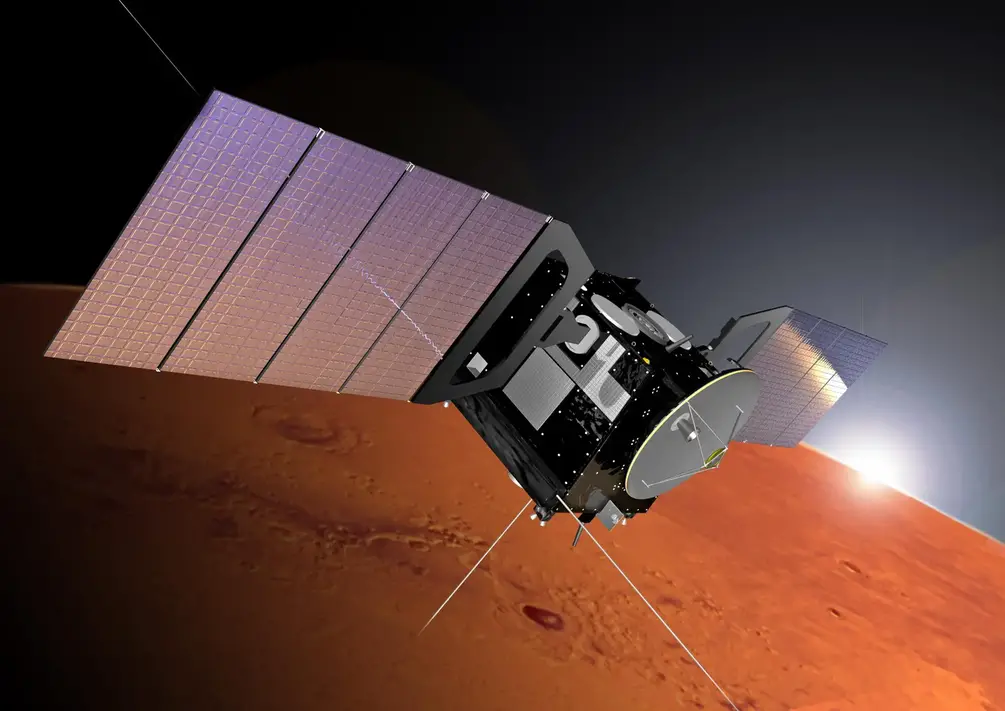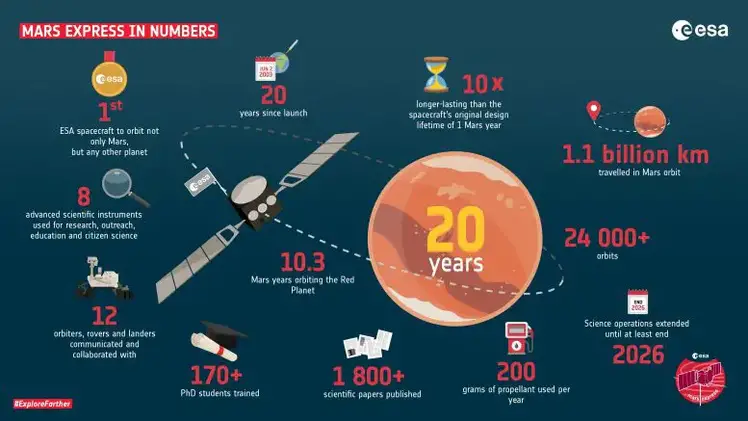Mars Express lifted off from Baikonur Cosmodrome aboard a Soyuz–Fregat rocket on June 2, 2003. It entered orbit around Mars on December 25 that year and reached its operational orbit in January 2004. The initial mission duration was one Martian year (687 Earth days), completed in September 2005. Credit: ESA/Alex Lutkus

Two decades ago, on June 2, 2003, ESA’s Mars Express orbiter launched and began its journey to the Red Planet – Europe’s first-ever mission to Mars.
The spacecraft aimed to enter orbit around Mars (something it did in December of that year) and use its vantage point to study the Martian atmosphere and climate, unravel the planet’s structure, mineralogy, and geology, and search for traces of water across its surface. The mission carried a state-of-the-art package of eight instruments to achieve this, enabling it to probe surface, subsurface, atmosphere, and more.

Two decades ago, on June 2, 2003, ESA’s Mars Express orbiter launched and began its journey to the Red Planet – Europe’s first ever mission to Mars. Credit: ESA
Mars Express has now been in space for two decades, despite a planned initial lifetime of just 687 Earth days. It has achieved its aforementioned aims and revealed a wealth of knowledge about Mars in that time, making it undeniably one of the most successful missions ever sent to the Red Planet. This graphic highlights some of the mission’s most impressive numbers to date, from the 1.1 billion km traveled over 24,000+ Mars orbits to the 170+ PhD students trained and 1800+ scientific papers published using Mars Express data. More record-breaking milestones were highlighted in an infographic released in 2019 to mark the mission’s 15-year anniversary.
The past 20 years of observations from Mars Express have solidified our picture of Mars as a once-habitable planet, with warmer and wetter epochs that may have been oases for ancient life. This is a monumental shift from our previous view of the planet, which characterized it as an eternally cold and arid world.
Mars Express has identified and mapped signs of past water across Mars – from minerals that only form in the presence of water to water-carved valleys, groundwater systems, and ponds lurking below ground – and traced its influence and prevalence through Martian history. It has peered deep into the Martian atmosphere, mapping how gases (water, ozone, methane) are distributed and escape to space, and watching as dust is whipped up from the surface into the air. The mission has seen giant dust storms engulf the planet, creating familiar clouds like those we see on Earth, and tracked rare ultraviolet auroras.
The orbiter has seen signs of recent and episodic volcanism and tectonics, and explored the planet’s unique surface features, mapping 98.8% of Mars and creating thousands of 3D images of impact craters, canyons (including the Valles Marineris system), the planet’s icy poles, immense volcanoes and more. It has studied Mars’ innermost moon Phobos in unprecedented detail – passing as close as 45 km from the mysterious moon – and watched Mars’ smaller moon, Deimos, as it travels through the Solar System.
Alongside its focus on Mars’ science, Mars Express has supported many other missions as they either hunt for a suitable landing site, travel to the planet, communicate with ground stations back on Earth, or touch down on the Martian surface. Its data continues to support significant scientific research and discovery, including the training of new and early career researchers who will reveal the secrets of the cosmos in the decades to come. And the mission’s support of Martian exploration is far from over; Mars Express’s latest extension enables it to support the JAXA-led Mars Moons eXploration (MMX) mission when it arrives in 2025.
Notes:
- Mars Express launched on June 2, 2003, and entered orbit around Mars on December 25, 2003
- The mission was originally designed to last 1 Mars year (1.88 Earth years, or 687 Earth days), but has been granted repeated extensions to continue its operations at Mars for 10.3 Mars years (and counting). The spacecraft celebrated 10 Martian years in orbit on 16 October 2022
- The orbiter will continue its study of Mars until at least the end of 2026, with an indicative extension from 1 January 2027 to 31 December 2028 to support the JAXA-led Mars Moons eXploration (MMX) mission, followed by two years of post-operations.
- Mars Express has conducted data relay for seven rovers and landing platforms, and enabled scientific collaboration with a further five orbiters
- The Visual Monitoring Camera was ‘upgraded’ to a scientific camera in 2016; there are seven other instruments that together make up the scientific payload.





